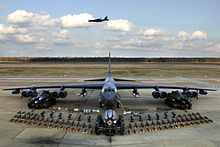Aircraft ordnance



Aircraft ordnance or ordnance (in the context of military aviation) is weapons (e.g. bombs, missiles, rockets and gun ammunition) used by aircraft. The term is often used when describing the weight of air-to-ground weaponry that can be carried by an aircraft or the weight that has been dropped. Aircraft ordnance also includes air-to-air, anti-ship and anti-submarine weapons.
Some aircraft types can carry a wide variety of ordnance – for example, the Fairchild AU-23 Peacemaker could use forward-firing gun pods, 500 and 250 pound bombs, napalm units, cluster bomb units, flares, rockets, smoke grenades and propaganda leaflet dispensers.[1]
Ordnance can be carried in a bomb bay or hung from a hardpoint.
For many weapons there is a limit to the length of time they can be flown (e.g. because of vibration damage); after this their safety or effectiveness is not guaranteed. This can be a problem if weapons designed for high intensity conflict are carried on multiple missions in a long counter-insurgency campaign.[2]
References[]
- ^ "Factsheets : Fairchild AU-23A". Nationalmuseum.af.mil. Archived from the original on 2014-01-05. Retrieved 2013-11-16.
- ^ De-classified summary of conference at UK Joint Services Command and Staff College reported in Aerospace International (magazine) March 2011 page 24
See also[]
- Aircraft weapons